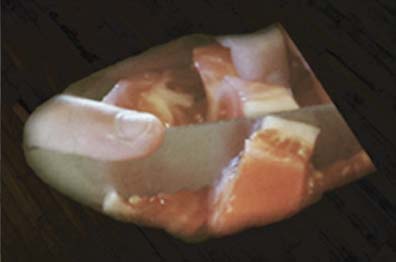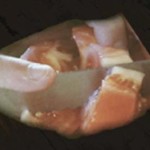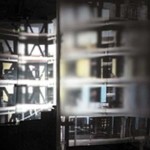The term fourth wall is from both theater and film that refers to the barrier between the audience and the action that they are viewing. It is most famously known through the act of breaking it down or breaking through it (think Brecht or any number of self referential television programs). It is a device to encourage the audience to think deeper about what they are seeing. But just what does it mean in the context of a video installation in a gallery?
The nature of video installation is to engage the visitor in a moment of interaction that is like, yet very un-like, the standard mediated dichotomy of viewer and subject. Most video installations fall back upon the standard cinematic environment of the darkened room simply with the notable lack of seating. There is rarely anything “installation-like” about it other that it happens to be “installed” in a gallery. There is no interacting, it is simply watching. It is here that Sheridan and Zimmerman play with the concept of the fourth wall. The FPAC is literally enclosed within a screen. The glass walls of the gallery allow for complimentary viewing between the café and the interior of the gallery. They stand in for Brecht’s metaphorical wall inviting the visitor inside to engage with the art.
The Fourth Wall consists of four projections in the gallery and one at street level placed in a window to the right of the building’s entrance. Michael Sheridan’s work consists of three in the gallery space and the one at street level while Andy Zimmerman has one large projection that occupies the right hand side of the gallery.
The first of Sheridan’s projections fills the left hand windows. Images of vegetables being chopped and placed in bowls move slowly across the panes. The images are shot from above at a medium distance. The hands and knives dance across the windows in symmetry with the café space creating a constant reminder of the relationship between us and the production of our food. The other two projections inside the gallery continue with the theme of food preparation. The first is a close up of vegetables in water and then being chopped. The images of the knife slicing are slowed to emphasize the actions involved. This is projected from the ceiling onto a bed of rice. The other projection, once again from ceiling to floor, is of dough slowly being mixed in a large industrial mixer. The camera lens shifts ever so slightly between medium and not so medium shots while the turning of the mixer mesmerizes with its rhythmic spinning. This is projected on white surface that is framed by a black shape about four feet across. The area is vaguely oval shaped.
The placement on the windows facing the café worked well. I visited the gallery when the café was closed but I imagine that Sheridan’s videos are quite engaging when surrounded by people eating and drinking. The two other projections didn’t seem to work as well. The shapes of the floor projections seemed arbitrary. I don’t imagine that they were as time and effort went into both but there was no way to enter into its meaning. The choice of rice as a material also struck me as peculiar. Rice does make an appearance in the video projected in the storefront upstairs but not in the video that is actually projected onto the rice. Nitpicking perhaps but why choose such a heavily loaded subject like rice and then do so little with it?
Sheridan’s videos are beautifully shot, with vibrant colors that emphasize the live-ness of his subject matter: vegetables. However, it is the execution (and at times those very same vegetables) that makes the piece go awry. In watching the vegetables being sliced and placed in large bowls I couldn’t help but feel I was engaging in a bit of vegetable voyeurism, watching food pornography; The knife slowly cutting into the flesh of the carrot combined with the sensuous moments of the hands moving and caressing the tomatoes. But everything was too clean, from the countertops to the vegetables themselves. It didn’t make me think of the violent nature of food production. It made me think of the food network. There was no visceral quality to it. It came across as sterile and remote. Perhaps that is the point? Our experiences with food have become removed from their problematic production aspects. We prefer our food to be packaged and easy to view.
Andrew Zimmerman’s video occupies the right hand side of the gallery. It is comprised of video projected onto a series of interconnected translucent panels. The imagery shifted from buildings and walls to rowers and water in a random manner that was being generated by a computer. The most engaging aspect of Zimmerman’s videos was the fact that as one tried to move closer the images dissipated. It was only viewable from afar. Alas, while interesting for its sculptural elements, the video itself felt more like a screensaver. Never really captivating or holding my attention.
Overall, The Fourth Wall succeeds in that it does bring one into the space to interact with the art. But it stops short of provoking a reaction. For Brecht, breaking through the fourth wall act was about pushing the viewer, getting them to think, disturbing their bourgeois existence. That is not what is happening here. Sheridan and Zimmerman succeeded in creating video installations that are aesthetically pleasing but they aren’t pushing boundaries.
- Examples of video installations featured in The Fourth Wall at Fort Point Arts Community Gallery: Michael Sheridan (top) and Andy Zimmerman (below).
Links:
Fort Point Arts Community
Fourth Wall
Bertolt Brecht
"The Fourth Wall" is on view until March 2nd at the Fort Point Arts Community Gallery, 300 Summer St. in Boston, MA. There will be a closing party and artist talk on Friday, March 2 at 6:30 PM
All images are courtesy of the artists and Fort Point Arts Community, Inc.






